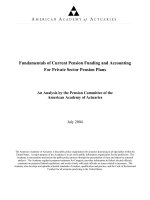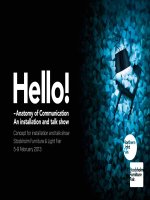Fundamentals of communication, p r and leadership
Bạn đang xem bản rút gọn của tài liệu. Xem và tải ngay bản đầy đủ của tài liệu tại đây (3.8 MB, 173 trang )
GEORGIOS P. PIPEROPOULOS
FUNDAMENTALS OF
COMMUNICATION,
PR AND LEADERSHIP
Download free eBooks at bookboon.com
2
Fundamentals of communication, PR and leadership
1st edition
© 2017 Georgios P. Piperopoulos & bookboon.com
ISBN 978-87-403-0484-8
Peer review by Professor Klaus Schoefer, Newcastle University Business School
Download free eBooks at bookboon.com
3
FUNDAMENTALS OF
COMMUNICATION,
PR AND LEADERSHIP
CONTENTS
CONTENTS
Prolegomena…
8
Part One – Communication
14
1
Communication is a universal phenomenon
15
1.1
System of 4 components
16
1.2
Communication among ants and bees
16
1.3
Communication among canines & felines
17
2
Human Communication
19
2.1
The scheme of human communication
19
2.2
Defining human communication
20
2.3
Language in human communication
22
2.4
Words in a language
23
2.5
Signs and Symbols
23
2.6
Semiotics and Semiology
26
2.7
The role of context and effect in communication
27
2.8
Barriers to communication
28
www.sylvania.com
We do not reinvent
the wheel we reinvent
light.
Fascinating lighting offers an ininite spectrum of
possibilities: Innovative technologies and new
markets provide both opportunities and challenges.
An environment in which your expertise is in high
demand. Enjoy the supportive working atmosphere
within our global group and beneit from international
career paths. Implement sustainable ideas in close
cooperation with other specialists and contribute to
inluencing our future. Come and join us in reinventing
light every day.
Light is OSRAM
Download free eBooks at bookboon.com
4
Click on the ad to read more
FUNDAMENTALS OF
COMMUNICATION,
PR AND LEADERSHIP
CONTENTS
3
Body language
31
3.1
Darwin’s contribution
31
3.2
The ‘intrigue’ of body language
32
3.3
Keeping matters at ‘arm’s length’
33
3.4
The role ‘culture’ plays
35
3.5
Focusing on the human face
37
3.6
Ardrey’s ‘territorial imperative’
39
4
Mass Media & social media
41
4.1
From stone inscription to the printing process
41
4.2
Enter the ‘penny press’ innovation
43
4.3
From the wired telegraph to wireless telegraphy
44
4.4
AM and FM radio come to existence
46
4.5
Birth and development of television
47
4.6
The digital age & ‘www’
49
5
The Role of attitudes in human communication
53
5.1
Defining Attitudes
53
5.2
The components of attitudes
55
5.3
Attitude functions for the personality
56
5.4
Our attitudes can change
57
5.5
Attitude measuring scales
58
Part Two – Public Relations
62
6
The birth of a speciality
63
6.1
Tracing P.R. roots in antiquity
64
6.2
A historic glimpse at the USA in late 19th and early 20th Century
65
6.3
Defining the field of Public Relations
69
6.4
Misconceptions of public relations
71
6.5
Brief profiles of four pioneers in P.R. history
72
7
Publics, Public Opinion and its moulders
75
7.1
Historical evolution of the term ‘public’
76
7.2
Public Opinion
77
8
Rhetoric, Persuasion and Propaganda
80
8.1
From Rome with…’love’
82
8.2
Not one but a multitude of definitions
83
8.3
A variety of propaganda types
85
8.4
World Wars & the use of Propaganda
88
8.5
The Korean War and “Brainwashing”
90
Download free eBooks at bookboon.com
5
FUNDAMENTALS OF
COMMUNICATION,
PR AND LEADERSHIP
CONTENTS
9
Corporate Communication & Responsibility
93
9.1
Corporate Communication
94
9.2
Corporate responsibility or CSR
97
9.3
PR vs. marketing and advertising
100
10
Press releases, special events and sponsorships
104
10.1
An in-house PR specialist vs. the services of a PR consultancy
104
10.2
The ‘press release’ or ‘news release’
106
10.3
Form & structure of a ‘press’ or ‘news release’
107
10.4
Content and Style of the ‘press or news release’
108
10.5
Different ‘releases’ to different Media
109
10.6
Emphasis on ethos, pathos and logos
110
10.7
Special events and sponsorships
111
10.8
Crisis management
114
Part Three – Leadership
116
11
Leaders and Leadership
118
12
Leadership, Power, Authority & Charisma
120
12.1
A glimpse at recent political, financial and religious events
120
12.2
Starting with Plato and Aristotle
123
12.3
Max Weber’s theoretical viewpoint
124
12.4
Enter Machiavelli, Sennet & Habermas
130
12.5
The era of ‘scientific management’ and the Hawthorne studies
131
13
Leadership research at the Universities of Iowa, Ohio & Michigan
134
14
Modern theories of leadership in Private and Public Enterprises
and Organizations
138
14.1
Contingency and path-goal theories
142
14.2
Transformational leadership – ‘Charisma’ revisited?’
145
15
Instead of an epilogue: Women leaders remain under a
‘glass ceiling’
150
15.1
Women in Politics
151
15.2
Women in the Economy and in Higher Education
152
16
References/Bibliography
157
About the Author
173
Download free eBooks at bookboon.com
6
To my son Dr. Panagiotis (Panos) G. Piperopoulos
Download free eBooks at bookboon.com
7
FUNDAMENTALS OF
COMMUNICATION,
PR AND LEADERSHIP
PROLEGOMENA…
PROLEGOMENA…
As we progress into the second decade of the third millennium, we experience, on a daily
basis, that our world is inundated with overwhelming amounts of visual, auditory and
written messages. hese messages carry a tremendous, perhaps immeasurable amount of
meanings, making it almost impossible for many people to receive, understand and use
these meanings in a positive way in their daily lives.
In the irst section of this textbook, we will be taking a brief glimpse, through available
historical documents, at media realities of the 19th century in the USA and will come across
the appearance and availability of Newspapers of the ‘penny press’ type, which managed to
conquer the masses and simultaneously the collective imagination of large audiences. Despite
its brevity, such a glimpse will bring forth the then prevalent ‘zeitgeist’ (the spirit of the
times) which was encapsulated in the belief held by their owners and the public that the
printed media had become and were destined to be the absolute protagonists in the process
of information dissemination. Today’s realities proved this belief to be mere wishful thinking.
Early in the 20th century, the century characterized by two World Wars, radio was invented
and soon became popular and ultimately readily available to large numbers of people. Radio
broadcasts materialized and brought to reality the tremendous capacity to carry, almost
immediately as they occurred, news and other messages to large audiences dispersed in vast
geographic areas bypassing, in a historically unprecedented fashion geographic limitations.
Radio, and radio broadcasts, as the means, as the channel of conveying messages from
senders to receivers, reigned supreme for several decades providing those that controlled
it with up to then unknown powers in communicating their messages to large audiences.
With radio as the protagonist, gaining the irst role in the process of information and
opinion dissemination, the printed media had to assume a new role. Indeed, surpassed by
the live immediacy of radio broadcasts, the printed media assumed the role of providing
to the mass audiences in-depth analyses and editorial views published half or a whole day
after events had occurred, in afternoon or morning editions of newspapers. When major
events did occur newspapers resorted to the now familiar ‘extra edition’ but even in such
cases Newspapers could not compete with the immediacy of radio broadcasted news and
opinion statements.
Download free eBooks at bookboon.com
8
FUNDAMENTALS OF
COMMUNICATION,
PR AND LEADERSHIP
PROLEGOMENA…
he development of the moving pictures as ilms projected on large screens, constituted
a landmark in visual communications. Initially ilms started as ‘silent movies’ lacking
synchronized sound and spoken dialogues. In these movies actors and actresses conveyed
messages through ‘pantomime’ and at intervals cards on which some words or sentences
were printed were projected on the screen as part of the intended ilm script. Eventually, the
development of relevant technology made possible the production of the so-called ‘talkies’
incorporating sound as musical background and voices in dialogues. he ilm industry,
through its products, managed to deliver messages to very large audiences worldwide. Indeed,
for a number of years ‘news’ were presented to cinema goers as ‘trailers’ on the screen prior
to the presentation of the movie they went to the cinemas to see. he ilm industry was,
and obviously continues to be dominated by the studios located in Hollywood, California
and a few western European production studios. For several decades of the 20th century
the ilm industry and radio programs became progressively the protagonists in Mass Media
of Communication threatening the established stronghold of the press (both newspapers
and magazines) in reaching far greater audiences faster than ever dreamed possible before.
As noted above, radio provided the tremendous advantage of conveying ‘live’ news and
opinions to their audiences compared to the newspapers handicap of presenting ‘ex post
facto’ news, their analyses and editorial opinions in late afternoon or next morning editions.
he printed media, however, in the form of morning and afternoon newspapers were able
to provide their audiences with in depth commentary retaining a competitive advantage
compared to radio messages. Additionally, embodying the maxim of ‘Verba Volant, Scripta
Manent’ (spoken words ly, written words remain) they could be read by several members
of each family and perhaps again and again, if needed, so as to gain better understanding.
he role of radio and the ilm industry was surpassed within the time span of only a few
decades, especially in the second half of the 20th century, once Television was invented and
through mass production television sets became available to increasingly large numbers of
households. Transmitting initially in black and white and eventually in full colour, television
programs assumed the unquestionable role of being the major ‘opinion maker and moulder’
medium on a world-wide scale. It would not be far-fetched to assume, perhaps, that this
unprecedented power over vast audiences lead Marshall McLuhan to respond with his well
known by now ‘the medium is the message’ aphorism-maxim when asked by journalists what
meanings or messages was TV conveying to its viewers.
Download free eBooks at bookboon.com
9
FUNDAMENTALS OF
COMMUNICATION,
PR AND LEADERSHIP
PROLEGOMENA…
In the last few decades, however, High-Tech products and digital technology, literally
progressing by leaps and bounds, has given to Information and Communication Technology
and its various artefacts the leading role in sending and receiving messages, that is in the
communication process on a global scale. It is at this point that an interesting and fast
developing reality relating to information dissemination through the so-called Mass Media
of Communication does merit a comment. he reality is that currently, on a global scale,
there exists a historically unprecedented broad spectrum of printed, auditory and visual
media in the form of newspapers and magazines, radio and television stations. he concern
raised in various quarters is not related to the vast numbers of newspapers, magazines, radio
and television stations but to the fact that, through mergers and acquisitions, a diminishing
number of privately owned companies belonging to a handful of so-called ‘media moguls’
owns and controls these media on national and international levels. he possibility that a
small number of corporations could end up controlling the mass media is emerging as a
potential threat to the needed polyphony in the news low.
All along, and in all fairness, it is generally admitted that the printed ‘messages’ in the form
of books which, historically, were shelved and preserved in the family’s bookcases, as well
as in town and city Libraries, kept convincingly fulilling their role in conveying meanings
to large audiences as did weekly, bi-weekly and monthly magazines. In fact while some
experts in the ields of communication and media believe that the modern forms of digital
technology will fully overtake the printing business, others insist that the readers’ have the
need and do enjoy holding a physical copy of a newspaper, a magazine, or a book. his
reality, according to the fans of ‘printed media’ will preclude their total disappearance from
the information and communication ield.
he book you are reading, in digital form and as its title suggests, constitutes an introductory
text made up of 15 chapters allocated in three parts: Communication, Public Relations and
Leadership. One of the objectives of this book is to familiarize the readers, on an introductory
level and in a heuristic manner, with the three fascinating areas contained in its title.
Admittedly, a supericial, but not frivolous, Google or Amazon search on the subjects of
Communication, Public Relations and Leadership will bring forth the reality that there exist
already in print or in kindle form dozens of thousands of academic books and research
articles as well as popular books and articles. his may justiiably give rise to a question
relating to the need and usefulness of publishing yet another book dealing with these
subjects. I will provide you below with two answers in case you are harbouring such a
question in your mind.
Download free eBooks at bookboon.com
10
FUNDAMENTALS OF
COMMUNICATION,
PR AND LEADERSHIP
PROLEGOMENA…
he irst relates to the publisher’s invitation to me to write this book. I was pleased by
the call and impressed by the realization that the very innovative entrepreneurial approach
adopted by the publishing house Bookboon would make this (as all of their books) available
to the readers free of charge! he perpetual popular maxim stating that usually ‘what is free
is of no value’ does not apply in this case as the quality of books published by Bookboon
proves. he second answer has to do with my belief that there is nothing wrong with adding
another book as a new and useful synthesis of things which other authors have said in their
personal creative way. Surely the inal decision on the usefulness of this book and the value
return for the time invested in reading it rests totally and exclusively with you as the readers.
he subtitle ‘I communicate therefore I am’ paraphrases the now classic maxim attributed
to the French philosopher Rene Descartes which was stated in Latin as ‘cogito ergo sum’
(in English ‘I think therefore I am’). I had paraphrased the Descartes aphorism initially
in Greek rendering it as ‘Επικοινωνώ άρα Υπάρχω’ (in English ‘I Communicate therefore I
am’) in the beginning of the 1990 decade and used it as the title for my television show
which aired every Saturday evening for several years in Greece’s National Television Station
‘channel 3’ transmitting from my hometown of hessaloniki. Deliberating on the style, form
and content of the show I decided to adopt in a TV program what was a widely known
type in radio shows where listeners call in and are heard live on the air having a dialogue
with the presenter. In my television show, I would open the show with a brief monologue
introducing a socially signiicant theme, for example, friendship, relations between parents
and children, home violence, happiness and success, substance abuse, antisocial behaviour
etc. Following my short monologue, the Station’s telephone operators would open up the
lines and viewers had a short live dialogue with me ofering their views on the speciic
subject discussed in my show.
Due to the success of my TV program I was asked to do a one hour same format live show
at the National Radio Station channel 3 of hessaloniki, Greece. It should be noted that the
radio show aired every Wednesday noon and was broadcasted in all three radio frequencies,
namely FM, AM and SW so that it could be received by Greek listeners, not only within
the physical boundaries of Greece, but other Greeks living in global ‘Diaspora’ as well.
My television and radio shows titled ‘I communicate therefore I am’ coincided with my
appointment to the Chair of Communication and Public Relations at the Department of
Business Administration of the University of Macedonia in hessaloniki. his was the irst
Chair on ‘communication and public relations’ established in a National Greek University.
Download free eBooks at bookboon.com
11
FUNDAMENTALS OF
COMMUNICATION,
PR AND LEADERSHIP
PROLEGOMENA…
My decision to paraphrase Descartes’ maxim ‘I think therefore I am’ to ‘I communicate therefore
I am’ related to my perception of the ‘zeitgeist’ of Descartes’ era when the human ability to
think was considered as proof of our existence. My feeling is that in our epoch, the ‘proof ’
of our existence rests on and relates to the various facets of communication. A brief look at
the trillions of messages exchanged on mobiles, the 24/7 broadcasts of a vast array of radio
and television programs, and the dozens of thousands of newspapers and magazines printed
in all languages around the globe should serve to support this perception. Relating to the
core verb ‘think’ in Descartes’ statement and the core verb ‘communicate’ in my choice to
paraphrase it I will ask you to bear with me in taking a brief look, in a purely philosophical
sense, to relevant propositions made twenty ive centuries ago by Plato an Aristotle.
Two millennia before Descartes, Plato, speaking through Socrates and going beyond the
concept of ‘sofrosyne’ (the Greek word ‘σωφροσύνη’ means wisdom) introduced in his dialogue
‘Charmides’ the concept of ‘επιστήμη’ which in English, means ‘knowledge of knowledge’, from
the Greek philosophic concept of ‘νόησις νοήσεως’ interpreted by many as ‘science’. Relevant
in this context is also Aristotle’s statement, preceding that of Descartes and introduced in
his ‘Nicomachean Ethics’: “…whenever we perceive, we are conscious that we perceive, and
whenever we think, we are conscious that we think, and to be conscious that we are perceiving
or thinking is to be conscious that we exist.” (he Nicomachean Ethics, 1170a25 f.)
360°
thinking
.
Discover the truth at www.deloitte.ca/careers
Download free eBooks at bookboon.com
12
© Deloitte & Touche LLP and affiliated entities.
Click on the ad to read more
FUNDAMENTALS OF
COMMUNICATION,
PR AND LEADERSHIP
PROLEGOMENA…
Closing the ‘prolegomena’ I owe an explanation to the readers concerning the fact that in
my book they will encounter frequent references to the two ancient Greek philosophers
Plato and Aristotle. his, in all honesty and certainly not in an apologetic fashion, is not
due to some subconscious, on my part, tendency towards ethnocentrism. It is dictated by
the persevering realization that a variety of concepts and terminology used in our current
study, discussion and understanding of communication, public relations and leadership (as
is the case with concepts and terminology in other social and physical or natural sciences)
have their roots in the thinking and writings of these men. It is within this ‘Weltanschauung’
(from the German philosophical viewpoint) that I bring to your attention a much publicized
quotation from a longer statement made by the British philosopher Alfred North Whitehead.
he eminent British scholar was clearly, as he publicly had admitted, an Aristotelian and
had served as the President of the UK Aristotelian Society in 1922–23. In 1929 publishing
as a metaphysical treatise the ‘Giford lectures’ he had successfully and with great acclaim
delivered at Edinburgh University by the title ‘Process and Reality’ he wrote and I quote
from the 1979 Free Press edition of that book:
‘…The safest general characterization of the European philosophical tradition is that it
consists of a series of footnotes to Plato. I do not mean the systematic scheme of thought
which scholars have doubtfully extracted from his writings. I allude to the wealth of general
ideas scattered through them…’ (p. 39)
Download free eBooks at bookboon.com
13
FUNDAMENTALS OF
COMMUNICATION,
PR AND LEADERSHIP
PART ONE – COMMUNICATION
PART ONE – COMMUNICATION
he irst section of this book aims to familiarize the reader with the various processes of
communication in the multitude of forms we encounter it.
he word ‘communication’ is directly derived from a Latin verb (commūnicāre, commūnicāt-)
meaning ‘to share, communicate, or impart’. his in turn comes from a Latin adjective,
commūnis, meaning ‘common or shared locally’. he term originally meant sharing of
tangible things, i.e. food, land, goods, and property. Today, it is applied to knowledge and
information processed by living things or by computers.
Going beyond the primeval person-to-person type of the communication process, historical
evidence conirms that in their communications the ancient Greeks used ire at night and
sun ray relecting mirrors in daytime while the Romans used the communication beacon
towers. In their communications the American Indians used daytime smoke signals and night
time ire arrows while drums and the sounds they produce were used for communication
purposes by various African tribes.
From the above simple and often cumbersome ancient communication systems mankind
has succeeded in inventing and using, for communication purposes, spoken and written
language, the printing press, land line telephone and now mobile/cellular phones, wired
and wireless telegraph, radio and television. It is commonplace today to communicate using
modern digital systems conveying on a global scale as well as in outer space instantly, iconic,
auditory and printed messages aided by satellites orbiting around the earth in outer space.
Indeed, personnel of private and governmental enterprises and organizations, as well as
journalists operating internationally, make extensive use of modern IT means, media and
artefacts (including Skype) as well as the ‘e-mails’, which are free to send and receive and
so their use has increased exponentially.
Download free eBooks at bookboon.com
14









